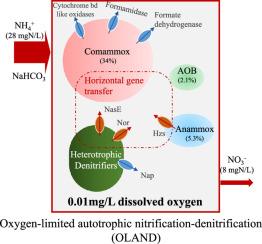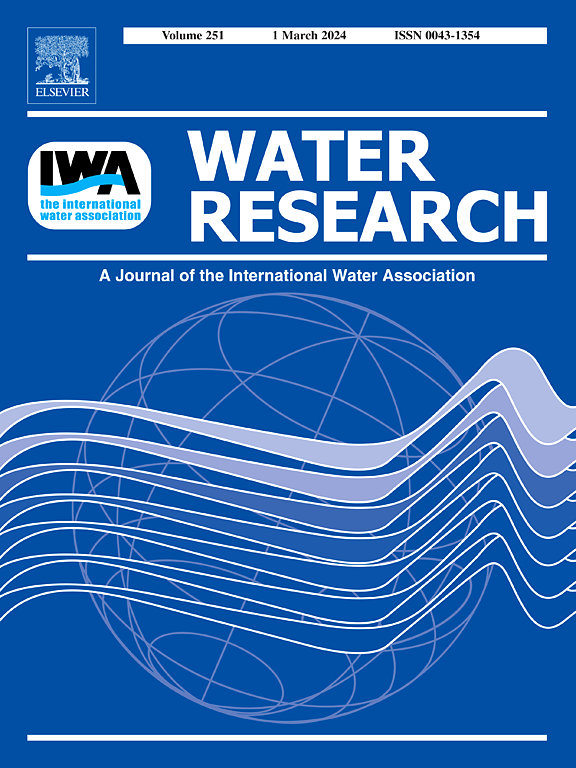在氧气极其有限的环境中,高效自养硝化-反硝化过程的主导是 Comammox 而不是 AOB
IF 11.4
1区 环境科学与生态学
Q1 ENGINEERING, ENVIRONMENTAL
引用次数: 0
摘要
氨完全氧化剂(comammox)的发现对两步硝化过程的传统认识提出了挑战。然而,它们在限氧自养硝化-反硝化(OLAND)过程中的功能仍不清楚。本研究利用 comammox为主的硝化细菌,在溶解氧浓度为 0.05 mg/L 的极度限氧环境中实现了 OLAND。当使用碳酸氢钠作为碳源时,氨氮去除率超过 97%,总氮去除率达到 71%。研究发现,伪一阶和二阶模型分别最适合低负荷和高负荷下的氨氮去除过程,这表明了不同的氨氮去除途径。全长 16S rRNA 基因测序和元基因组研究结果表明,在不同的氧含量条件下,以 comammox 为主,同时存在 anammox 和异养反硝化菌。参与能量代谢的酶的丰富程度表明,氨氧化作用和自养硝化-异养反硝化途径共存。分选结果表明,兼氧细菌与硝化细菌、兼氧细菌和反硝化细菌进行了水平基因转移,以适应强制性环境。因此,该研究表明,复合氧化菌、厌氧菌和异养反硝化菌在 OLAND 过程中发挥了重要作用,为进一步降低自养脱氮过程中的曝气能提供了参考。本文章由计算机程序翻译,如有差异,请以英文原文为准。

Comammox rather than AOB dominated the efficient autotrophic nitrification-denitrification process in an extremely oxygen-limited environment
The discovery of complete ammonia oxidizer (comammox) has challenged the traditional understanding of the two-step nitrification process. However, their functions in the oxygen-limited autotrophic nitrification-denitrification (OLAND) process remain unclear. In this study, OLAND was achieved using comammox-dominated nitrifying bacteria in an extremely oxygen-limited environment with a dissolved oxygen concentrations of 0.05 mg/L. The ammonia removal efficiency exceeded 97 %, and the total nitrogen removal efficiency reached 71 % when sodium bicarbonate was used as the carbon source. The pseudo-first- and second-order models were found to best fit the ammonia removal processes under low and high loads, respectively, suggesting distinct ammonia removal pathways. Full-length 16S rRNA gene sequencing and metagenomic results revealed that comammox-dominated under different oxygen levels, in conjunction with anammox and heterotrophic denitrifiers. The abundance of enzymes involved in energy metabolism indicates the coexistence of anammox and autotrophic nitrification-heterotrophic denitrification pathways. The binning results showed that comammox bacteria engaged in horizontal gene transfer with nitrifiers, anammox bacteria, and denitrifiers to adapt to an obligate environments. Therefore, this study demonstrated that comammox, anammox, and heterotrophic denitrifiers play important roles in the OLAND process and provide a reference for further reducing aeration energy in the autotrophic nitrogen removal process.
求助全文
通过发布文献求助,成功后即可免费获取论文全文。
去求助
来源期刊

Water Research
环境科学-工程:环境
CiteScore
20.80
自引率
9.40%
发文量
1307
审稿时长
38 days
期刊介绍:
Water Research, along with its open access companion journal Water Research X, serves as a platform for publishing original research papers covering various aspects of the science and technology related to the anthropogenic water cycle, water quality, and its management worldwide. The audience targeted by the journal comprises biologists, chemical engineers, chemists, civil engineers, environmental engineers, limnologists, and microbiologists. The scope of the journal include:
•Treatment processes for water and wastewaters (municipal, agricultural, industrial, and on-site treatment), including resource recovery and residuals management;
•Urban hydrology including sewer systems, stormwater management, and green infrastructure;
•Drinking water treatment and distribution;
•Potable and non-potable water reuse;
•Sanitation, public health, and risk assessment;
•Anaerobic digestion, solid and hazardous waste management, including source characterization and the effects and control of leachates and gaseous emissions;
•Contaminants (chemical, microbial, anthropogenic particles such as nanoparticles or microplastics) and related water quality sensing, monitoring, fate, and assessment;
•Anthropogenic impacts on inland, tidal, coastal and urban waters, focusing on surface and ground waters, and point and non-point sources of pollution;
•Environmental restoration, linked to surface water, groundwater and groundwater remediation;
•Analysis of the interfaces between sediments and water, and between water and atmosphere, focusing specifically on anthropogenic impacts;
•Mathematical modelling, systems analysis, machine learning, and beneficial use of big data related to the anthropogenic water cycle;
•Socio-economic, policy, and regulations studies.
 求助内容:
求助内容: 应助结果提醒方式:
应助结果提醒方式:


